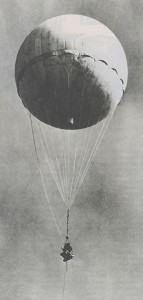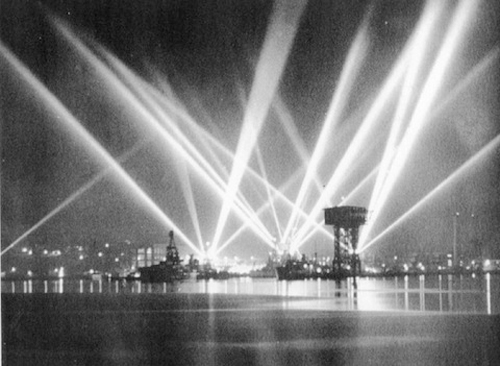
Picture taken from Los Angeles Harbor in the early morning hours of February 25, 1942, showing anti-aircraft spotlights searching the sky during the "Great Los Angeles Air Raid" which turned out to be a false alarm.
When most people think of World War II they are reminded of places such as Normandy, Pearl Harbor, Germany, Okinawa, or other places far from the continental United States. But some of the attacks on the United States occurred right here in our own backyard.
World War II, or the Second World War, took place from 1939 to 1945 involving a majority of the world’s nations, including the United States. The United States entered World War II when war with Japan was declared on December 8, 1941 the day after the Japanese attacked the U.S. Naval Base at Pearl Harbor in Hawaii. Three days later on December 11, 1941, Germany declared war on the United States. Both Germany and Japan wanted to bring the war to our shores.
In January of 1942 the German Navy launched “Operation Drumbeat”. This operation involved the sending of U-Boats to attack shipping off of the East Coast of the United States. (U-Boat was the German designation for a full size submarine) The United States, having no experience of a modern naval war close to its own shores, did not employ blackouts, or any increased naval patrols. The U-boats simply waited and picked off ship after ship in broad daylight, and at night as the ships were silhouetted against the lights of the major cities. Sometimes the U-Boats attacked on the surface, using their deck guns to save torpedoes, people on shore sometimes witnessed these attacks firsthand.
Some of the U-Boats destined for the United States, had orders to enter the Caribbean and Gulf of Mexico where fifty-six ships would be sunk with an additional fourteen ships damaged. U-507 shocked U.S. authorities by torpedoing and sinking the gasoline tanker Virginia in the mouth of the Mississippi River on May 12, 1942 with the loss of twenty-six sailors. Another one of the ships sank in the Gulf of Mexico was the freighter Oaxaca, which was torpedoed and sank eleven miles from Port O’Connor by U-171 on July 26, 1942.
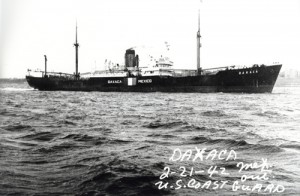
Freighter Oaxaca, which was torpedoed and sank eleven miles from Port O’Connor by German Submarine U-171 on July 26, 1942. Picture courtesy of Henry Wolff Jr.
The U-boats did more than attack ships: in June of 1942, U-202 surfaced off of Long Island, New York and dropped off four spies with explosives. That same month U-584 also dropped off four spies near Jacksonville, Florida. All eight of the spies were later captured by the FBI before they were able to carry out their intended plan of sabotaging power plants and blowing up aluminum production facilities. Six of the eight spies were sentenced to death and the other two were given prison sentences, both were released in 1948. The Germans tried to land more spies in November of 1944 when U-1230 dropped off two spies near Hancock Point, Maine. Their mission was to infiltrate the Manhattan Project, which was the U.S. Project to develop the first nuclear bomb. Both of the spies were captured and sentenced to death; however both sentences were commuted to life imprisonment, one was released in 1955, the other in 1960.
In September of 1943, U-537 set-up an unmanned automatic weather station north of Maine in Newfoundland. The weather station only worked for a couple of days and remained undetected after the war. The weather station was a secret known only to a handful of German sailors and scientists. The story became known in the late 1970’s, when an engineer with Siemens named Franz Selinger decided to write a history of the German Weather Service after his retirement. During his research, he found information about the weather station and contacted authorities to see if it had ever been found. Canadian and U.S. Authorities had no record of a German weather station being found on the East Coast. After a search the weather station was finally found in 1981 mostly intact; it is now on display at the Canadian War Museum in Ottawa, Ontario.
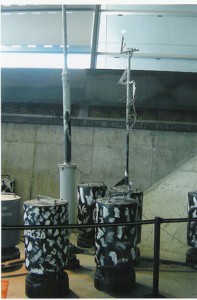
German automatic weather station which was installed in Newfoundland during World War II and found in 1981, on display at the Canadian War Museum in Ottawa, Ontario. Picture courtesy of the Canadian War Museum.
The Japanese were more ambitious than the Germans regarding attacks on the mainland United States. After the December 7, 1941 attack on Pearl Harbor, Several Japanese I-Boats were sent to the West Coast of the United States. (I-Boat was the Japanese designation for a full size submarine) Around 7:00pm on the night of February 23, 1942, Japanese Submarine I-17 surfaced near Santa Barbara, California. Using his 5.5 inch diameter deck gun, Captain Kozo Nishino fired at the oil storage facilities of the Ellwood oil field. Firing around 25 rounds, he then withdrew, later radioing Japan that he had “left Santa Barbara in flames”. Actually only a catwalk, some pumping equipment, and a derrick were slightly damaged. News of the attack triggered a panic along the U.S. West Coast.
This incident was the first direct attack by an enemy on the continental United States since the War of 1812.
Japanese forces invaded the Alaskan Islands of Attu and Kiska on June 3, 1942 and held them for almost a year. U.S. and Canadian forces fought the Japanese in several land and sea battles in miserable cold wet conditions. Eventually the Japanese abandoned Kiska, but Japanese troops on Attu held out until May 29, 1943 when they were defeated after mounting the largest banzai charge (suicide attack) of World War II. The charge, led by Colonel Yamasaki, penetrated far enough into U.S. positions to encounter shocked rear support units. After brutal hand-to-hand combat, the Japanese troops were killed almost to the last man, with only 28 surviving out of the almost 3,000 who participated in the charge.
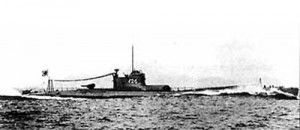
Japanese Submarine I-25 which shelled Fort Stevens and launched the airplane that bombed the continental United States twice in 1942. Picture courtesy of www.combinedfleet.com
On the evening of June 21, 1942, Japanese Submarine I-25 surfaced near Fort Stevens, Oregon. Fort Stevens was a U.S. Military Base that guarded the mouth of the Columbia River, which was important as cargo ships for the war effort were being built at facilities along the river at the time. Using his deck gun, I-25’s Captain Tagami Meiji fired around 30 rounds at the base before disappearing beneath the waves. The only damage was the baseball field backstop, and some power and telephone lines.
I-25 returned to the United States in September 1942 with the mission of using its floatplane to drop incendiary bombs on forests with the intent of starting large forest fires. I-25 carried a small floatplane with its wings folded back in a special watertight hanger on the deck. Pilot Nubuo Fujita was specifically chosen for the bombing missions. On September 9, the submarine crew deployed the floatplane which dropped two bombs near Brookings, Oregon. This attack by an enemy airplane was the first time that the continental United States was ever bombed by an enemy aircraft during wartime. Light winds, wet weather conditions, and two quick-acting Forest Service Fire Lookouts kept the fires under control. The floatplane launched again in the early morning hours of September 29 and dropped two more bombs near Port Orford, Oregon. While the plane was seen to drop its bombs, firefighting crews from a nearby Forest Service Ranger Station were unable to locate any evidence of the two incendiary bombs. The floatplane was again recovered by I-25, but Captain Meiji decided not to risk a third flight with the remaining incendiary bombs. I-25 went on to sink two U.S. cargo ships and the Russian Submarine L-16 off of the U.S. West Coast before returning to Japan. A U.S. sailor who was onboard the L-16 as a liaison officer during its voyage to Russia, was killed along with the rest of the L-16’s crew. I-25 would be sunk less than a year later by the destroyer USS Paterson on August 25, 1943.
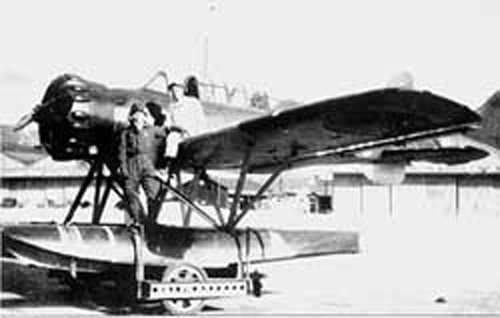
Japanese Pilot Nobuo Fujita posing in front of I-25's airplane, which he used in the two bombing raids on the United States.
Between November 1944 and April 1945, the Japanese launched thousands of “fire balloons” toward North America. A Japanese fire balloon consisted of a large balloon filled with hydrogen carrying either a 26-pound incendiary bomb or a 33-pound anti-personnel bomb. Four smaller 11-pound incendiary devices were attached as well. Designed to make use of the Pacific Jet Stream, a crude timer was supposed to release the bombs and explode the balloon three days after launch, when the balloon was expected to be over the United States. But the timer often failed and intact balloons with their dangerous cargo were often found on the ground. A few hundred fire balloons were reported as reaching North America, but little damage was caused. U.S. Authorities instituted a “press blackout” on any reported Japanese balloons as they did not want the Japanese to know that some of the balloons were actually making it to the United States. A pregnant pastor’s wife and five children of their Sunday school class on a field trip became the only deaths. The children found a balloon on the ground and one of the children tampered with one of the bombs and it exploded, this happened near Bly, Oregon. The remains of fire balloons continued to be found in remote areas long after the war ended, the last reported finding of one was in 1978.
During the War, many false alerts and enemy sightings were reported along the West Coast, the most famous of these happened the night after the Ellwood oil field attack by the Japanese Submarine I-17. Early on the morning of February 25, 1942; Japanese airplanes were supposedly sighted and air raid sirens were set off in Los Angeles County. At 3:16am U.S. Coastal Artillery began firing anti-aircraft shells into the air at reported aircraft; over 1,400 shells would eventually be fired. The anti-aircraft fire continued until 4:14am when the “all clear” was finally sounded. In addition to several buildings damaged, three civilians were also killed by falling shells, and another three died of heart attacks attributed to the stress of the hour-long firing. Within hours of the end of the air raid, U.S. Authorities held a press conference, saying the entire incident was a false alarm due to anxiety and “war nerves”. The incident was front-page news across the United States and is referred to in history as the “Battle of Los Angeles” or the “Great Los Angeles Air Raid”. The comedy war movie “1941” which was released in 1979 and directed by Steven Spielberg is loosely based on this incident and the Ellwood oil field shelling.
World War II ended with Germany’s surrender on May 8, 1945 and Japan’s surrender on August 15, 1945. Pilot Nubuo Fujita, who had bombed the United States using the I-25’s floatplane, managed to survive the war. In 1962 Fujita was invited to Brookings Oregon, near where he had dropped his first bombs. He gave the City of Brookings his family’s 400-year-old samurai sword in friendship where it is still on display at the library. Ashamed of his actions during the war, he was surprised when the town treated him with respect and affection, although his visit still raised some controversy around the United States. He passed away on September 30, 1997, at the age of 85. In 1998, his daughter, Yoriko Asakura, buried some of Fujita’s ashes at the Brookings bombing site.
